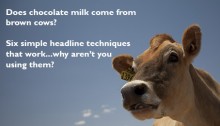Tag: writing
-
Is blogging dead in 2015?
No, it’s alive and well especially in agriculture. Blogging isn’t dead even though the big names in marketing and tech claim it to be almost every year. Here’s one from 2012 / Fast Company. And then this year, supposedly it’s doing great. Of course the company, GigaOM isn’t. But that’s beside the point. When it…
-

Why aren’t you using these top six simple headline techniques?
Copywriting doesn’t have to be hard but it can definitely seem hard at first. By following some simple techniques it can get a lot easier. Here are some of my favorite headline tips. 1. Should you write your headline first? No. Wait, yes. That doesn’t make any sense. Now I know that this can be counter…
-
How do you write for the web?
How do you write for the web? Recently I’ve been asked about writing on the web. Who are the experts? What are they doing? Have things changed? From what I have read and know, writing for the web has changed. Not in the fact that if you write simple and clear, use space and short…
-
Web Writers Needed – All The Time, Every Time
Every project, every time, it always comes down to the content. It’s very weird to me that no one questions the content in a print project – it’s required. The content helps drive the design and needs to be finalized (or as close as it can get) before we begin designing the piece. But when…